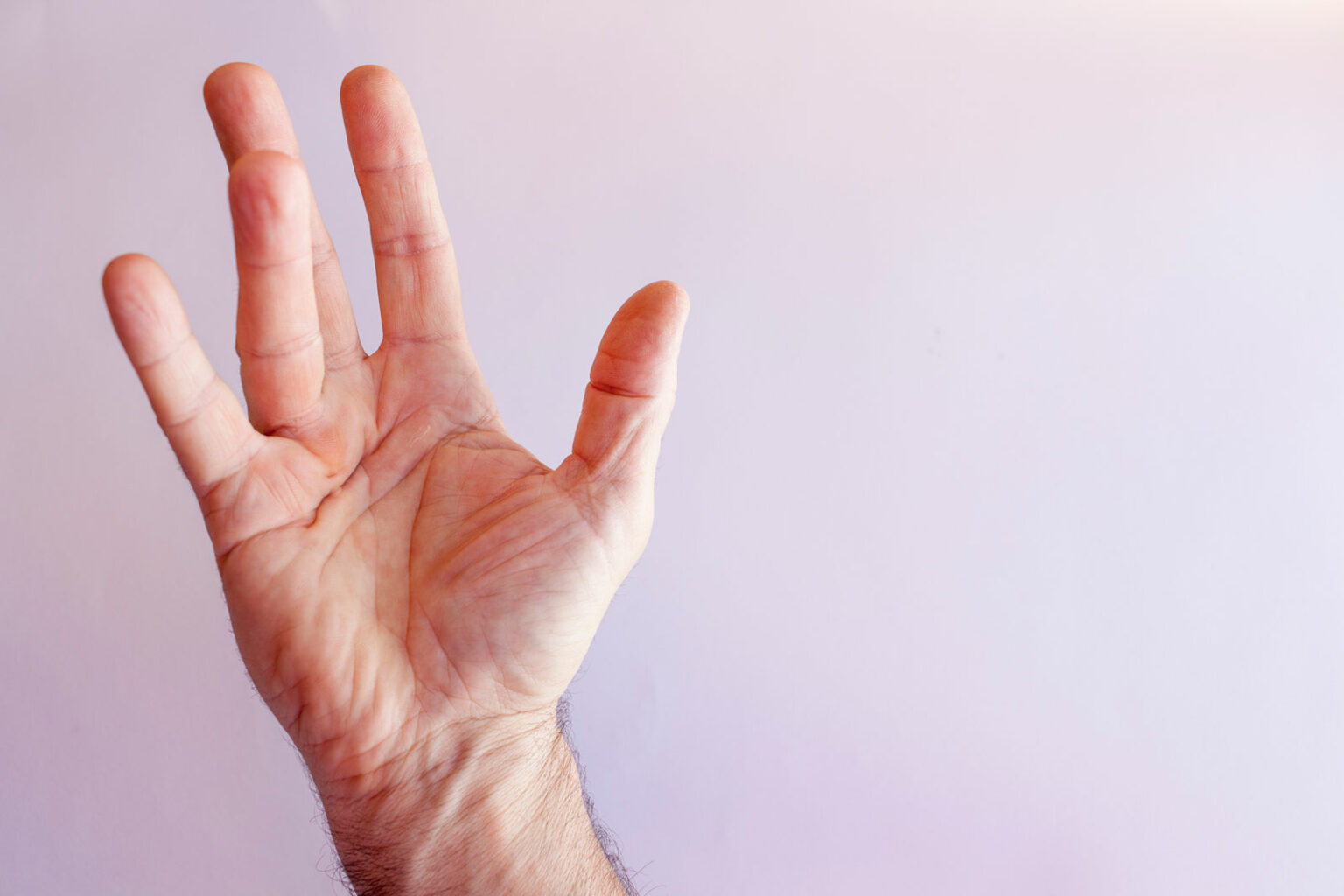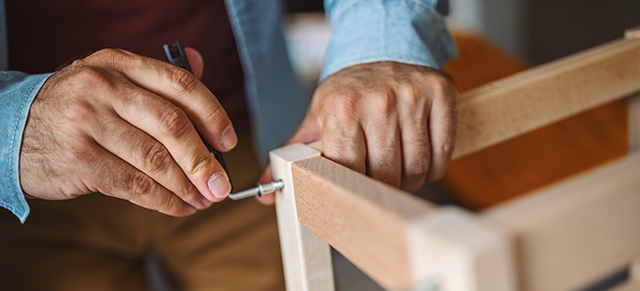Dupuytren’s Contracture
Dupuytren’s contracture symptoms can often interfere with hand function, making it difficult for some people to perform their daily activities.
While there is no cure for Dupuytren’s contracture, the condition is not dangerous. However, treatment for Dupuytren’s contracture can slow the disease or help ease your symptoms.

Plastic + Hand offers non-surgical and surgical treatments to best address your diagnosis and needs.
WHAT IS DUPUYTREN’S CONTRACTURE?
Dupuytren’s disease is a condition that affects the palmar fascia, the fibrous layer of tissue that lies underneath the skin in the palm and fingers. The palmar fascia forms a protective barrier between the skin and tendons (cordlike fibers that connect muscle to the bone) and gives the palm a flexible firmness.
Dupuytren’s disease causes the fascia to thicken and tighten over time, causing the fingers to be pulled inward towards the palm, resulting in a “Dupuytren’s contracture.” Nodules (small hard knots) may form just under the skin near the base of the fingers, and hard bands may also form across the palm. These nodules, bands, and contracting palmar fascia make the fingers bend toward the palm. There may also be pitting on the surface of the palm as the diseased tissue pulls on the overlying skin.
The ring finger and little fingers are most commonly affected, but any (or all) fingers can be involved, even the thumb. Most commonly, the finger’s first joint (knuckle joint) is affected, but other joints may also be involved. A worsening Dupuytren’s contracture can interfere with hand function in some patients.
As the bend in your finger increases, it may be hard to straighten it fully. It may also be difficult to grasp large objects, put your hand in your pocket, or perform other simple activities.
WHAT ARE DUPUYTREN’S CONTRACTURE CAUSES?
While the gene responsible for Dupuytren’s contracture is known, several factors may contribute to the development or worsening of Dupuytren’s disease, including:
- Heredity
- Being male (more likely to develop this condition than women)
- Northern European (English, Irish, Scottish, French, and Dutch) and Scandinavian (Swedish, Norwegian, and Finnish) ancestry
- Certain medical conditions like diabetes and seizure disorders
- Seizure medication is also a risk factor
- Being older (usually starts in middle age)
WHAT ARE DUPUYTREN’S CONTRACTURE SYMPTOMS?
Some common Dupuytren’s contracture symptoms include:
- Not being able to lay your hand flat on a table with your palm down (tabletop test)
- Having one or more small, tender lumps (nodules) in the palm. These nodules are typically fixed to the overlying skin. At first, the nodules may feel tender, but this tenderness usually goes away over time.
- Experiencing thickening and contracting nodules that form dense and tough cords of tissue under the skin. These cords may restrict or tether the fingers and thumb from spreading apart or straightening.
- Having pits or grooves in the skin compressed by the contracted finger. These areas can become sore and/or lead to skin loss if they don’t heal properly.
- Having fingers that are pulled forward.
- Experiencing some hand function loss.
WHAT IS THE PROGRESSION OF DUPUYTREN’S CONTRACTURE?
In many cases, a Dupuytren’s contracture progresses slowly and may not need treatment. However, treatment is necessary in moderate or severe cases when it’s difficult to straighten the involved digits. Treatment can help reduce the contracture and improve motion in the affected fingers. As the Dupuytren’s contracture worsens and the fascia involvement becomes more severe, a full correction may be more difficult.
HOW DO YOU DIAGNOSE DUPUYTREN’S CONTRACTURE?
At the Maine Hand Center at Plastic + Hand, we start this process by listening. We ask patients about their symptoms and the hand concerns they are experiencing.
The surgeon will perform a thorough evaluation, first asking about your health and family history, followed by a physical hand and finger examination. This evaluation helps determine the most appropriate Dupuytren’s contracture treatment plan.
WHAT ARE DUPUYTREN’S CONTRACTURE TREATMENT OPTIONS?
While there is no cure for Dupuytren’s contracture, the condition is not dangerous. However, Dupuytren’s contracture treatment can slow the disease or help ease your symptoms. Plastic + Hand offers different options depending on where you are in this disease progression and what the surgeon recommends as the most appropriate treatment.
These Dupuytren’s contracture treatment options may include:
- Steroid shot injections: These may help ease the pain if a lump is painful and help break apart the thickened tissue. While a corticosteroid injection (or repeated injections) may slow the progression of Dupuytren’s contracture in some cases, the effectiveness of this injection varies from patient to patient.
- Xiaflex (collagenase) injections: If the contracture interferes with hand function, the Plastic + Hand surgeon may recommend injection of a medication called Xiaflex (collagenase) that helps dissolve the thickened tissue in the 2-3 spots where it is injected. Xiaflex can help loosen up the hand and improve motion. As compared to surgery, the recovery is shorter, but the results are generally less complete and shorter-lasting.
- Dupuytren’s contracture surgery: If the contracture interferes with hand function, the Plastic + Hand surgeon may recommend surgical treatment to help reduce the contracture and improve motion in the affected fingers.
WHAT IS DUPUYTREN’S CONTRACTURE SURGERY?
In Dupuytren’s contracture surgery, the surgeon will first mark the surgical area, and you will be placed under local anesthesia to numb the area for surgery or general anesthesia if the contracture is more extensive. This is all done successfully in the comfort of our accredited outpatient Plastic + Hand Surgery Center located on-site here in Portland, Maine.
The surgical procedures most performed for Dupuytren’s contracture are:
- Fasciotomy: The surgeon will make an incision in your palm and divide the tissue’s thickened cord(s). While the cord is not removed, this division helps decrease the contracture and increase the movement of the affected finger.
- Subtotal palmar fasciectomy: For this procedure, the surgeon will make an incision and remove as much of the abnormal tissue and cord(s) as possible to straighten your finger(s). As a more extensive procedure than fasciotomy, it typically has a longer healing time and more follow-up care.
Both procedures help restrict the cords’ effect by disrupting or removing them. While the healing tissues will form with the same potential to develop cords in the future, the gains in hand function can still be substantial. You can discuss the potential outcomes more in-depth in your consultation.
WHAT TO EXPECT AFTER DUPUYTREN’S CONTRACTURE SURGERY
Patients often have normal pain, swelling, and stiffness after the procedure. It’s also normal to lose flexion of the involved digits due to stiffness.
Since Dupuytren’s contracture varies, there is no one-size-fits-all recovery timeline. While most Dupuytren’s contracture procedures take three months for patients to heal, full recovery may take up to one year.
Depending on your surgical procedure, your Plastic + Hand surgeon will provide specific post-op instructions for your recovery.
If you have surgery, you will have splints to protect the surgical site, and you will also meet with our occupational therapists for follow-up care to help improve strength and function in your fingers/hand. Please note that splinting on its own is not known to prevent the progression of a finger contracture. If splinting is not an approved part of your plan, this forceful stretching of the contracted finger may cause a potential injury to the finger and/or hand.
HOW MUCH DOES DUPUYTREN’S CONTRACTURE TREATMENT COST?
You’ll discuss your Dupuytren’s contracture treatment plan with your Plastic + Hand surgeon. During your initial consultation, your surgeon will evaluate your medical history, your symptoms, and discuss the best treatments and procedures for your diagnosis.
After this personalized consultation, our scheduling and pre-authorization team will work with you and your insurance company to ensure the procedure is covered and scheduled in a timely manner.
OUR PLASTIC + HAND SURGEONS ARE THE MOST TRUSTED TEAM FOR HAND SURGERY PROCEDURES AND DUPUYTREN’S CONTRACTURE TREATMENT OPTIONS IN MAINE.
If you’re considering hand surgery or non-surgical treatment for your Dupuytren’s contracture, our Plastic + Hand team has the most qualified hand surgeons in Maine. Not only have we successfully completed the most reconstructive procedures in the region, but our team is also the only plastic surgery team trusted by MaineHealth Maine Medical Center Portland and Biddeford campuses and Northern Light Mercy Hospital.
Plastic + Hand surgeons offer a comprehensive range of advanced procedures and treatments to address various hand conditions. Hand surgery procedures treat traumatic and post-injury problems, carpal tunnel, osteoarthritis, tendonitis, ganglion cysts, and congenital abnormalities.
In many cases, surgery is just the start of recovery, and intensive rehabilitation may be necessary to increase hand strength and function. That’s why Plastic + Hand includes occupational therapists as important members of our team to provide treatment for patients with hand injuries.
It’s time to discover the results you seek, offered with the respect and compassion you deserve. The first step begins here.
Please have your doctor reach out to us to start the process today. They can fax your referral to our office at 207-879-1646 or call us at 207-775-3446 with questions.

